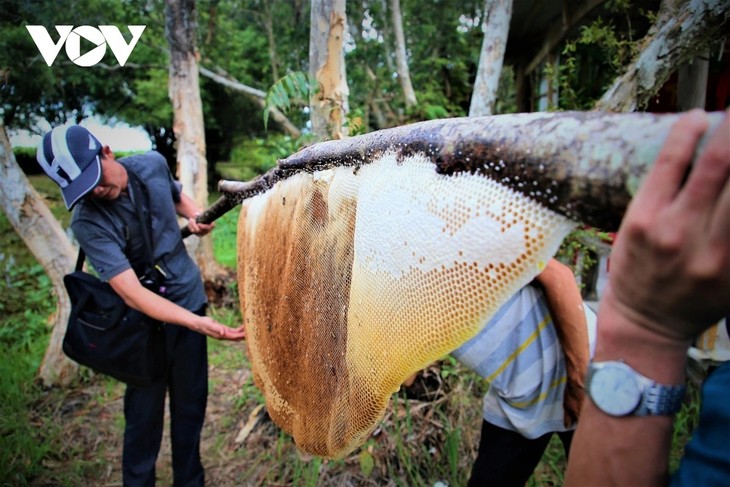The U Minh Ha area of Ca Mau province is preparing to enter its “spring.” That’s what forest workers call the honey-harvesting season - when the rains cease, the cajeput trees burst into bloom, and migrating bee colonies return. What once depended entirely on nature has evolved into a recognized cultural-heritage profession. Local forest workers have turned trellis beekeeping into a stable source of income.

The traditional trellis beekeeping is recognized as a national intangible cultural heritage in 2019. (Photo: Tran Hieu/VOV-Mekong Delta)
The ninth and tenth lunar month, when heavy rains drive the bees away, is the toughest time in U Minh Ha’s cajeput forests. In the eleventh lunar month, when sunshine returns, so do the bees. From then until the third or fourth lunar month is honey-harvest season - what locals affectionately call U Minh Ha’s spring.
Seizing rare sunny intervals between long stretches of rain, Huynh Vu Hoang strips the bark off one-meter cajeput trunks from his family’s plot, dries them, polishes the surface and drills two small openings. Years ago, forest workers had to haul trellises on their shoulders through dense reeds. Today, they glide along narrow canals - called “luong” - in small sampan boats to transport the trellises deep into the forest.

Many eco-tourism sites in the U Minh Ha forest have considered the trellis beekeeping their main tourism product. (Photo: Tran Hieu/VOV-Mekong Delta)
Each worker tends a family plot of cajeput. During their rounds, they mark promising locations, clear the reeds, and set up trellises to attract wild bees. In the rainy months, bees still build hives but produce little honey, Hoang says.
“After putting up 20 to 30 trellises, we return a week later to check them. If bees have settled, we note the date. Two weeks after they arrive, we can harvest. A one-meter hive can yield nine to ten liters in a single cut,” said Hoang, adding, “The second harvest may be even better. For that round, we wait longer - eight to twenty days - and trim part of the young comb. If we don’t, it gets too heavy, so we have to clean it up.”
Trellis beekeeping in U Minh Ha is now recognized as a National Intangible Cultural Heritage. In the past, bees nested high in treetops. Over time, by observing bee behavior and forest conditions, local workers developed a unique skill - the art of reading sunlight and wind deep within the forest, passed down through generations.
Trellis placement changes with the seasons. In the cold rainy months, bees need more warmth, so workers orient the trellis so that two-thirds face the sun. In the dry season, when sunlight is intense, the trellis is positioned to capture only one-third of direct light, as excessive heat discourages bees from nesting.
Forest worker Pham Duy Khanh explains, “You have to understand the bees’ habits to adjust the trellis. When workers find a good spot, they remember it, but sometimes they still have to shift the trellis slightly. The most important factor is wind. If the reeds sway too much, they block the bees from landing. The second factor is sunlight - it determines whether the hive produces abundant honey.”
On clear days before “spring” arrives, forest workers guide tourists into the forest to watch honey being harvested. Huge hives stretching a meter or more leave visitors amazed.

Visitors can experience how local people raise bees and harvest honey. (Photo: Tran Hieu/VOV-Mekong Delta)
In 2015, Ca Mau province promoted community-based tourism in U Minh Ha, giving trellis beekeeping new momentum. When the cajeput flowers bloom, visitors follow forest workers to observe the hives and witness the harvesting process - a vivid glimpse into the community’s bond with forest and nature.
During the harvest, workers always leave part of the hive intact so the colony can regenerate. Tourism has boosted honey prices, giving families better, more stable incomes. Beekeeper Pham Van Ngot says, “The trellises attract plenty of bees. If we set up 40 trellises, at least 20 will have colonies. Some seasons are better than others, but it still earns more than farming. It’s a good livelihood. We love trellis beekeeping.”
In U Minh Ha, generations have protected the green forest so the bees will return every year, carrying with them the scent of fresh honey. Every trellis represents countless days under sun and rain and the forest workers’ hope for a better life in the cajeput woods.
Huyen Trang